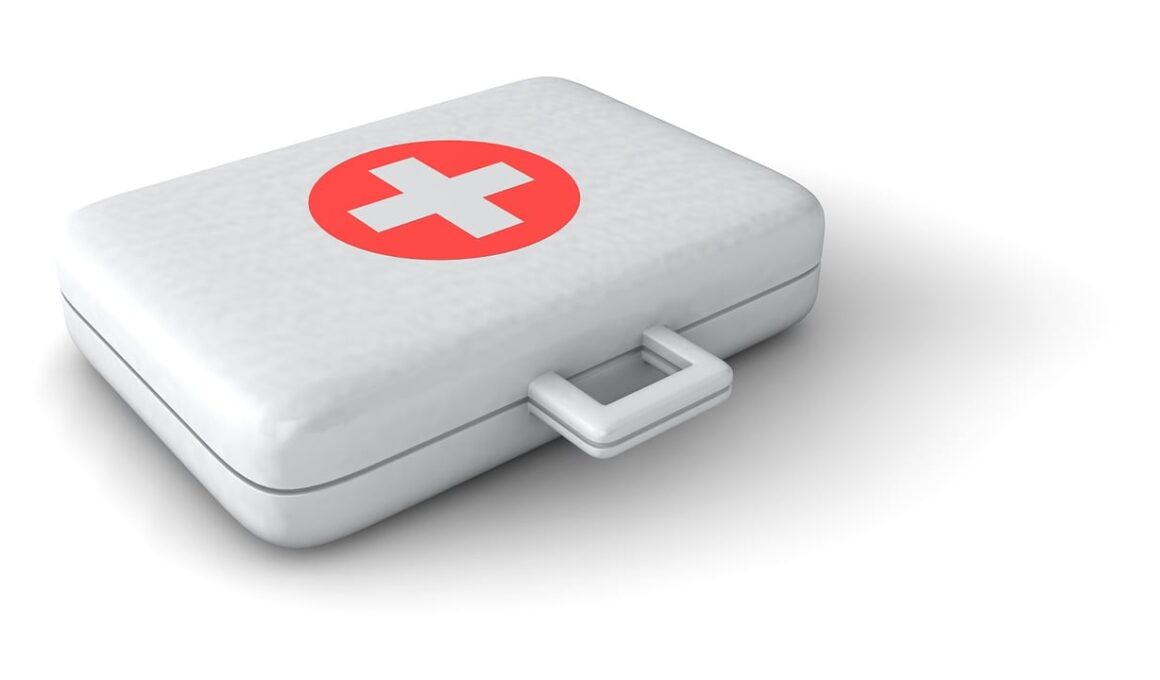First Aid Kit for Dogs: Products That Save Lives
A well-stocked First Aid Kit for Dogs is crucial for every pet owner. Dogs can get into various accidents, so being prepared can save their lives. Start by including a variety of essential items: gauze pads, adhesive tape, antiseptic wipes, a digital thermometer, and scissors. The inclusion of a muzzle is also vital for safety during emergencies. It’s important to remember that dogs may bite when they’re injured or frightened. Bandages are another key component for wrapping wounds. Make sure varied sizes are available to accommodate all types of injuries. Furthermore, a pair of tweezers can help remove splinters or ticks. Don’t forget about a first aid book specifically for pets, guiding owners in assessing and treating injuries. For more complex injuries, a pet CPR kit could be included; knowledge here is key. Each item serves a specific purpose, ensuring you are prepared for various emergencies that may arise. Ultimately, tailoring your kit to your dog’s needs will enhance its effectiveness in a crisis, adding extra peace of mind for every dog owner.
Besides the basic components, you might consider additional supplies in your dog’s first aid kit. It’s crucial to think about medications as well. Keep a copy of your vet’s contact information and any necessary medical records. In case of an allergic reaction due to an insect bite or sting, having antihistamines can be lifesaving. Also, a small bottle of hydrogen peroxide can induce vomiting in certain emergency situations. Tailor your first aid kit based on prior medical histories, such as allergies. If your dog has undergone surgery, keep a sterile wound dressing on hand. It’s also wise to add a splint for fractures, as mobility aids help give you time to reach a veterinarian. As you prepare the kit, think about equipment that can assist in transporting an injured dog safely. A dog stretcher or blanket can help in this context. Remember to routinely check and restock the kit after use. Keeping items updated ensures their effectiveness during emergencies, which can happen unexpectedly in everyday life.
Understanding Common Emergencies
Recognizing common emergencies affecting dogs will help guide your actions in a crisis. Various situations may arise, including choking, cuts, or allergic reactions. For choking, it’s important to know how to perform the Heimlich maneuver on dogs. If a cut occurs, clean the wound immediately to prevent infection. Use antiseptic wipes and cover the injury with a sterile bandage. My dog once experienced a serious allergic reaction, which created panic. Understanding symptoms like swelling, itchiness, or difficulty breathing can prepare you for a critical response. Anaphylaxis requires urgent medical attention, and being informed can save valuable time. Additionally, knowing how to stabilize your dog while waiting for professional assistance is essential. For fractures, carefully immobilize the bone until a vet can assess the situation. Never forget that calmness is vital during emergencies; your dog can sense your anxiety. If your pet is unconscious or unresponsive, immediate veterinary attention is crucial. Having someone ready to transport your dog can help alleviate stress. Proper education on these scenarios can enhance your ability to respond effectively during emergencies, ensuring better outcomes.
Preparing for trips, whether small or large, also involves ensuring your dog’s first aid kit is ready for any irresponsible situations. Storing a first aid kit in both the home and your car is essential; emergencies occur wherever you are. When traveling, always have treats or familiar items that comfort your dog during stressful moments. Including your dog’s prescription medications is extremely beneficial for prolonged trips. Make sure you are also equipped to handle dehydration, which is a significant concern for pets. A portable water bowl and some extra bottle water can keep your dog hydrated. In addition, always be aware of seasonal hazards; for instance, certain plants can be toxic or harmful during walks. Leashes, and muzzles should be part of your travel essentials. Also, consider bringing a portable pet first aid guide that can help in remote situations. Being aware of nearby veterinary services can assist you if unexpected injuries occur. Ultimately, preparedness before embarking on a trip ensures that both you and your dog have an enjoyable experience, minimizing risks.
Staying Informed About Canine Health
Keeping up-to-date on canine health and first aid procedures is crucial for every dog owner. Regularly attending workshops or seminars focusing on pet first aid can be invaluable. Knowing CPR and basic medical skills can empower you to act quickly in emergencies. Many organizations provide comprehensive training on pet care and health issues, equipping owners with the knowledge needed in crises. Maintaining open communication with your veterinarian also plays a significant role; they can guide treatment plans and preventive care strategies. Part of that is understanding how to recognize signs of illness before they escalate. Weight, behavior, and eating habits can indicate underlying problems. In addition, keeping up with vaccinations and preventative medications contributes to your pet’s ongoing health. If you identify a potential issue, don’t hesitate to seek veterinary advice promptly. Having written notes with dosages and treatment histories can enhance your overall understanding as well. To keep your dog healthy, proactive measures remain essential. Staying informed will also help you act confidently in times of emergency.
Inspecting your dog regularly is an essential way to maintain their health and catch possible issues. Various conditions can arise that require immediate attention, such as skin irritations or dental concerns. Brushing your dog’s coat not only keeps it clean but allows for regular checks of the skin underneath. Dogs can experience ticks, fleas, and even lumps that need veterinary assessment. Careful dental inspections can reveal problems like tartar buildup or gum disease, which can affect their overall health. Monitoring your dog’s weight is equally important; obstructions can result from excessive weight gain or loss. By keeping a close watch on your dog’s health, you’re positioned to react promptly to any troubling signs. Engaging with your vet regularly for check-ups should also be prioritized. Each visit is an opportunity to gather more information on your pet’s overall wellbeing. It allows you to maintain confidence in your ability to care for them. When all else fails, knowing when and how to seek professional help is critical. You ultimately want what is best for your furry friend.
Conclusion: Be Prepared for Anything
In conclusion, being adequately prepared with a first aid kit for dogs can make a substantial difference in emergency scenarios. Each essential item discussed contributes to enabling swift interventions when necessary. Regular inspections of the kit and its content ensure readiness for incidents. Continuous education on canine health also enhances your ability to respond. Understanding common emergency signs and knowing appropriate actions guide your efforts in saving your dog’s life. Always remain composed during crises; your actions and demeanor can profoundly affect your pet’s reaction. Proper storage of supplies, along with easy access, guarantees you won’t waste any time when it matters. Prioritizing structured training and consultations with your vet sharpens your readiness. Together, these efforts equip you for any unforeseen situations. Ultimately, your dedication to your dog’s wellbeing will help them lead a happier and safer life, where risks are recognized, and responses are swift. Remember, caring for your dog also means being proactive in preventing emergencies through education and preparation. This way, you ensure a wonderful relationship filled with love and safety.
In conclusion, being adequately prepared with a first aid kit for dogs can make a substantial difference in emergency scenarios. Each essential item discussed contributes to enabling swift interventions when necessary. Regular inspections of the kit and its content ensure readiness for incidents. Continuous education on canine health also enhances your ability to respond. Understanding common emergency signs and knowing appropriate actions guides your efforts in saving your dog’s life. Always remain composed during crises; your actions and demeanor can profoundly affect your pet’s reaction. Proper storage of supplies, along with easy access, guarantees you won’t waste any time when it matters. Prioritizing structured training and consultations with your vet sharpens your readiness. Together, these efforts equip you for any unforeseen situations. Ultimately, your dedication to your dog’s wellbeing will help them lead a happier and safer life, where risks are recognized, and responses are swift. Remember, caring for your dog also means being proactive in preventing emergencies through education and preparation. This way, you ensure a wonderful relationship filled with love and safety.


